Download
VirtualMEC User Manual in English (

2.87 MBytes).

Download
VirtualMEC User Manual in French (courtesy of Rick Demil) (

1.50 MBytes).

Download
VirtualMEC User Manual in Dutch (courtesy of H. Meeusen) (

1.17 MBytes).

In this Tutorial you will build a simple Scooter model, the one shown in Figure 1. You will be driven through the process of building a complete VirtualMEC model. Sometimes you will be reminded to save the model built so far. You can do this only if you own the retail version of VirtualMEC, since the demo version does
not allow you to save models. The folder where VirtualMEC has been installed contains several files named "Scooter phase 1", "Scooter phase 2", etc. These files correspond to the various building phases of the Scooter model. If you are not planning to follow the whole Tutorial in one session, you can
refer to these files as a starting point for each phase. You will find references to each phase during the course of the Tutorial.
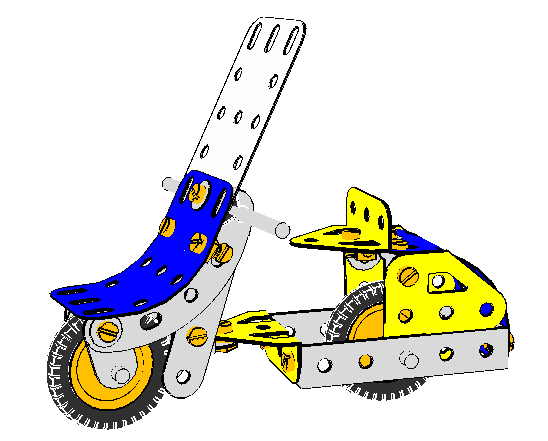
Figure 1. The model to be built.
If you have just started VirtualMEC, you should have a blank document window open. If this is not the case, please close any open document windows and then open a new one selecting File New
 .
.
Verify that Flat Colour Rendering button
 is pressed.
is pressed.
Let's start with the first part we want to add to the model. You can choose any part you like to start with; in this case we will start with the central Trunnion No. 126. The Parts Bar should be visible on the right. If not you can click
 to show it. Now you can locate the Trunnion. Please take a moment to explore the different views of the Parts Bar; you may want to choose the type of view you are more comfortable with. You can also dock or undock the Parts Bar, as you prefer, by dragging the top handle. Once you have selected the
Trunnion, click
to show it. Now you can locate the Trunnion. Please take a moment to explore the different views of the Parts Bar; you may want to choose the type of view you are more comfortable with. You can also dock or undock the Parts Bar, as you prefer, by dragging the top handle. Once you have selected the
Trunnion, click
 .
.
Now you have a Trunnion displayed in the document window of VirtualMEC. Let's spend some time exploring the various ways to look at it using different points of view.
Verify that the Drag toolbar button  is pressed. Just click and drag your mouse around the model to see it from different points of view following your mouse movements. You can zoom in
is pressed. Just click and drag your mouse around the model to see it from different points of view following your mouse movements. You can zoom in
 and out
and out  and you can pan the model using the scrollbars or clicking and dragging using your mouse central button or mouse wheel. Once you have mastered the various movements,
end with the Trunnion in about the same position as in Figure 1.
and you can pan the model using the scrollbars or clicking and dragging using your mouse central button or mouse wheel. Once you have mastered the various movements,
end with the Trunnion in about the same position as in Figure 1.
Now it's time to add a Bolt to the Trunnion. Locate the correct hole nearest to you, where you want to fix the Double Angle Strip No. 48a. Simply click in that hole. A Bolt No. 37b will appear in the chosen hole. The Bolt is selected (red colour) so that you can operate on it. The first thing to do is change its direction.
While it is still selected, click on the Invert button
 .
.
Now you can add the Double Angle Strip No. 48a. Locate it in the Parts Bar and double-click it. The Double Angle Strip adds itself to the selected Bolt, through the correct hole, but it is incorrectly rotated. Click on it to select it, then press the Rotate 180° button
 . Now it should be in the correct position. Re-select the Bolt and add a Nut to it by pressing the Add Nut button
. Now it should be in the correct position. Re-select the Bolt and add a Nut to it by pressing the Add Nut button
 .
.
Repeat the same procedure to add the other Double Angle Strip.
It's now time to add the rear axle and wheel. Select part Axle Rod No. 17 in the Parts Bar, then locate the central hole of the left Double Angle Strip. Verify that the corresponding hole of the other Double Angle Strip is NOT visible through the first hole, then click in the first hole. The Axle Rod appears.
Double-click on the Axle Rod just added and a couple of movement arrows appear. You can click and drag the red straight arrow to verify that the movements of the Rod are constrained by the hole you clicked in. Leave the Rod in a half-way position with respect to the hole.
With the Axle Rod still selected (if it is not selected, click on it), add the following parts: a Flat Trunnion No. 126a, a Spring Clip No. 35, a Pulley No. 22 which forms the wheel, another Spring Clip and another Flat Trunnion. It doesn't matter for the moment if the Trunnions are not correctly oriented, you can adjust
their positions later. You should have reached a result similar to the one in Figure 2.
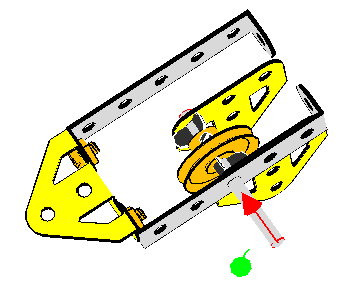
Figure 2. The rear axle.
Verify that the Axle Rod movement arrows are still displayed (otherwise double-click on the Axle Rod) and make use of the red arrow to correctly position the Axle Rod. It should extend by the same amount from each Double Angle Strip. Yet even though the Axle Rod now passes through the hole of the second Double Angle
Strip, VirtualMEC is still not aware that the hole and Axle Rod belong together. To let it know that, you must "hook" the Axle Rod; once it is selected, click the menu Part Hook.
We can now proceed to correctly position all the recently added parts. Start with the last Trunnion. First of all, make sure all parts are deselected by clicking outside the model. Then double-click on the Trunnion and drag its big red arrow until it reaches the corresponding Double Angle Strip. Since every part is hooked,
no parts should go beyond their allowed range. While the Trunnion is selected, you can rotate it to the correct position using the Rotate 90° button
 .
.
In the same way, position the Spring Clip against the Trunnion and the Pulley wheel in the middle of the Axle Rod. Finally, rotate the first Trunnion to the correct position.
Adding the Motor Tyre to the wheel is extremely easy: select the Pulley wheel, then locate the Motor Tyre No. 142c in the Parts Bar. Double-click it.
Your model is beginning to grow. Now’s the time to save it. Click the Save button, choose the desired folder and give it a name. You should periodically save your models to avoid losing your work if an error occurs.
It's now time to add the rear Plastic Plate. First of all click in the last hole of the left Double Angle Strip to create a Bolt. Correctly orient the Bolt by inverting it (click the Invert button
 ). Add the Plastic Plate No. 194. You will notice that the Plastic Plate has been added to the Bolt, but not through the correct hole. With the Bolt still selected, click in the desired hole in the Plastic Plate; the Plastic Plate will jump to the new position.
Select and rotate the Plastic Plate to make it vertical. Your model should now look similar to the one in Figure 3.
). Add the Plastic Plate No. 194. You will notice that the Plastic Plate has been added to the Bolt, but not through the correct hole. With the Bolt still selected, click in the desired hole in the Plastic Plate; the Plastic Plate will jump to the new position.
Select and rotate the Plastic Plate to make it vertical. Your model should now look similar to the one in Figure 3.
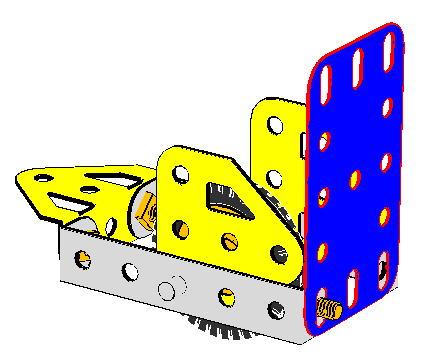
Figure 3. The rear Plate about to be bent.
We can now proceed to bend the Plastic Plate. With the Plastic Plate selected, click the menu Part Add Bend. Locate the bend arrow and drag it until the Plate has a right angle bend. You may want to find a point of view that is more suitable for that operation. Remember that you can always drag the image to find a better
view. If you have trouble with your first bending, don't worry. You can always undo your last actions, by clicking the Undo button
 , and try again until your model looks like Figure 4.
, and try again until your model looks like Figure 4.
If, during the process of bending, you inadvertently click outside the part, the bend selectors disappear. To have them reappear, click the part to be bent, then click the menu Part Edit Bending, then select the bend (the red sphere) and you are back again.
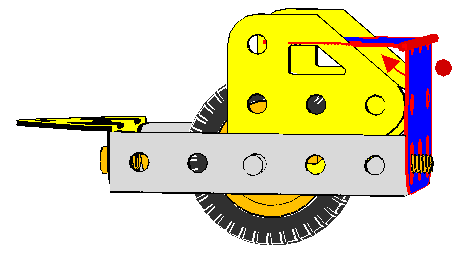
Figure 4. The rear Plate initially bent.
To begin with the bend is quite sharp; we need to soften the curve. With the Plate selected, click the menu Part Soften Bend twice. Little spheres will appear about the bending axis. Drag one of them until you reach the following figure. If you can’t see the spheres, try zooming the image.
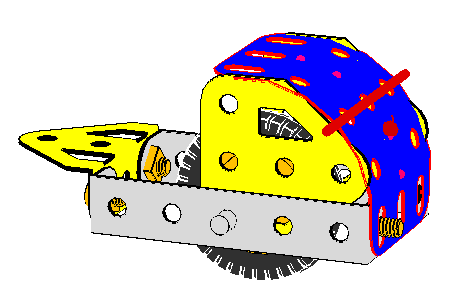
Figure 5. The rear Plate correctly bent.
The Plate is now correctly bent. You can deselect it by clicking anywhere outside the model.
If, after building more of the model, you want to go back and adjust the bend, you may find that the Bend menu is greyed out. This happens if the Plate is fixed by more than one Bolt, and bending would be impossible in real life. You need to remove (or unhook) all-but-one of the Bolts (or Axles), and the Bend menu should
reappear.
It's now time to make some fine adjustments to the model. As you can see, the bent Plate and the Trunnions intersect at some points and that looks ugly. VirtualMEC is not able to make the necessary adjustments by itself, instead it gives you all the tools you need to make them yourself.
First of all, the bent Plate should be raised a bit over the Trunnions' edge. Double-click the Plate, a number of arrows appear, and you can click and drag the little straight vertical one until the Plate is in the desired position.
The Trunnions also need to be moved away from the Plate slightly. You can obtain a satisfactory result by rocking them along the Axle Rod. Double-click a Trunnion, then alternately click and drag the two little curved arrows until you reach the desired position. Feel free to experiment until you are comfortable with
every movement. Always keep in mind that the Undo button
 is available to you.
is available to you.
When you need very fine adjustment, you can use a nice VirtualMEC feature called Remote Control. Let's suppose you need to orientate a Trunnion vertically. Simply click the correct arrow (without dragging it); VirtualMEC automatically remembers the last arrow clicked or dragged. Then rotate the model so you get
a good point of view. Now, if you press Ctrl while you drag the mouse, VirtualMEC acts as if you were dragging the arrow itself, even if you are not actually dragging it. It's like having an invisible arrow just under your mouse.
Once you have practiced Remote Control for a while, you will realize that finding the correct position for any part that needs fine adjustment is easy and fast.
Now it's time to add the tail lights and obtain the result shown in Figure 6. Proceed as follows.
For the left light, select the Bolt on the left side of the body and click the Add Washer button
 . Invert the Bolt and add a Nut to it. Now click in the corresponding holes in the right side; invert the Bolt, add a Washer, re-invert the Bolt and add a Nut.
. Invert the Bolt and add a Nut to it. Now click in the corresponding holes in the right side; invert the Bolt, add a Washer, re-invert the Bolt and add a Nut.
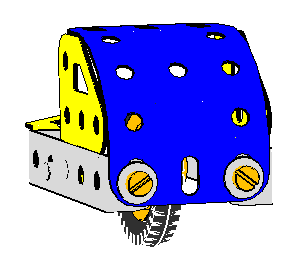
Figure 6. The rear part of the model.
We can now proceed with the saddle. We need a couple of Angle Brackets No. 12 to fix the upper part of the Plate to the Trunnions. Click in one of the elongated holes on the edge of the Plate and then add an Angle Bracket. You will want to bolt the elongated hole of the Angle Bracket to the Plate, so click in
that hole while the Bolt is selected and the Angle Bracket will jump into place.
Now you can do a couple of things. Double-click the Angle Bracket and make use of the correct arrow to slide it against the Trunnion. Again, to do so, find a comfortable point of view and use Remote Control if you need it. The holes in the Angle Bracket and the Trunnion are probably not in perfect alignment. You may
need to slide the Angle Bracket a little bit forward. To do so, double-click the Bolt (arrows appear), then click the Plate (new arrows appear). Dragging these arrows will move the Bolt and everything attached to it, but NOT the Plate you clicked. Try it until you are comfortable with this “double plus single” click feature.
(Remember to use the Undo button, if something goes wrong.)
Complete with Nuts and Bolts and do the same for the other side. Your model should now look like the one shown in Figure 7.
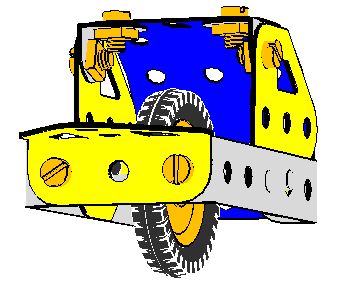
Figure 7. The rear part of the model almost complete.
The saddle is a Trunnion No. 126 attached to a Fishplate No. 10, which is attached in turn to the central elongated hole of the Plastic Plate. You should be able to complete it by yourself. See Figure 8 for reference.
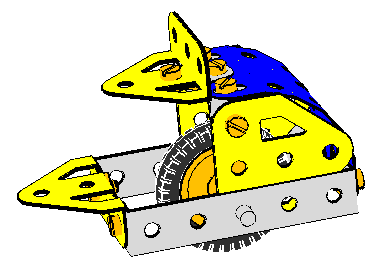
Figure 8. The rear part of the model complete with the saddle.
You are now ready to proceed with the front part of the model. Figure 9 shows the front assembly with the Trunnion and a Perforated Strip No. 5 made transparent in order to see the inner details.
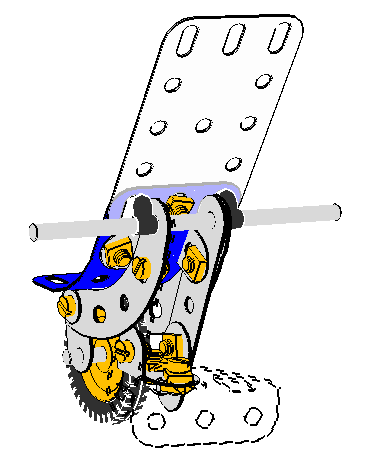
Figure 9. The front part of the model.
A Fishplate No. 10 is lock-nutted to the front hole of the Trunnion. Click in the Trunnion's front hole, add a Nut, add a Fishplate and finally add another Nut. The Fishplate needs to be rotated by 90°. You should be able to do all this by yourself.
The other end of the Fishplate must now be bolted inside a Double Bracket No. 11, with uprights pointing upward. Click in the front hole of the Fishplate to create a Bolt, then, with the bolt still selected, add a Double Bracket. With the Bolt still selected, choose the correct hole of the Double Bracket (the central
one). The Double Bracket will jump into place, but is still not correctly oriented. Select, invert and rotate the Double Bracket as necessary until it’s facing the way you want. Invert the Bolt and add a Nut to it. Your model should now look like Figure 10.
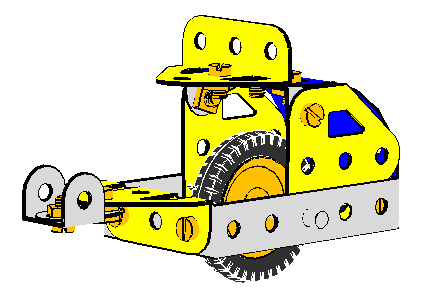
Figure 10. The model so far.
It's now time to add the two Perforated Strips No. 5 to the Double Bracket. Since we do not want the steering column to be exactly vertical, we will need to rake the Perforated Strips backward. We could do so by rotating each of them individually until they are perfectly aligned, but in this case we'll use a different
approach that makes it easier to achieve perfect alignment. Proceed as follows.
Add the two Strips in the vertical position. To do so, click in the hole in one of the uprights of the Double Bracket, invert the Bolt if needed, add the Perforated Strip, click in its second hole to reposition the Strip, invert the Bolt again and add a Nut. Do the same for the other Strip on the other upright. Your
model should now resemble Figure 11, with both Strips pointing vertically into the air.
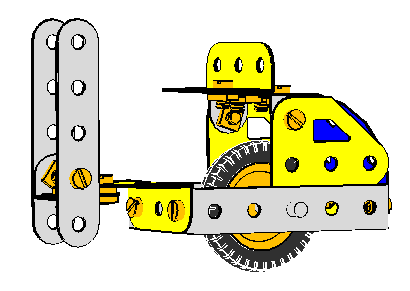
Figure 11. The steering column in vertical position.
Now let's add the handle-bar through both Perforated Strips. To do so, first select Axle Rod No. 16 in the Parts Bar, then click in the top hole of both Perforated Strips. Position the model until you can see the second hole through the first one. Click in the hole and the axle appears. If you have done
everything correctly, you should be able to verify that this new handle-bar is “hooked” to both the Strips. Please do so: double-click the Axle Rod and move the red arrow. You shouldn't be able to unthread the handle-bar from the Strips.
It's almost time to rake the steering column. But first, let's say a few words about how VirtualMEC handles movements of parts. If you double-click a part, VirtualMEC displays a set of arrows that originate from one of the holes containing a Bolt or Axle Rod. For example, if you double-click one of the Perforated Strips
No. 5 that you have just added, VirtualMEC will display a set of arrows around the hole containing the handle-bar. Try it. Now, if you click the Bolt, the set of arrows will move there. Please note that you have NOT selected the Bolt, you have simply changed the reference hole for turning operations. The Strip is still
selected. Now, what happens if you, say, drag the green arrow?
The Perforated Strip will rotate (in fact it's the selected part) with respect to the reference hole (the red hole with the turning arrows). Other parts that the Bolt passes through will not turn, and neither does the Bolt itself. But the handle-bar, because it is “hooked” to the Strip, will follow the movement of the
Strip, as will all other parts attached to the handle-bar: in particular the second Strip and its Bolt, and, through them, every other part of the model, since they are all connected. But we did not want the whole model to rotate around the reference Bolt. But you should try it, just to see what happens. Then remember
to press the Undo button
 to go back to the previous situation.
to go back to the previous situation.
So what do we have to do if we want to rotate the steering column, and nothing else? The problem arises because the Bolt on the second Strip is “hooked”. If we remove this Bolt, the problem no longer exists. Or, even better, we can “unhook” it. Unhooking stops the Bolt from propagating the movement of the second Strip
to the other parts of the model.
[NOTE] Beginning with release 1.2.4, VirtualMEC has the ability to automatically detect Bolts and Axle Rods that are coaxial with the Bolt that is acting as a pivot. So unhooking coaxial Bolts or Axle Rods is not needed anymore (VirtualMEC will do it for you). So, in this particular case, unhooking is not necessary. Anyway
it is still recommended that you practice with unhooking, since in other situations that might be needed.
Once you have understood the logic just explained, the task is very simple. Select the Bolt you want to unhook and click the Part Unhook menu. Now double-click the first Strip, click the Bolt around which you want to rotate the steering column, and drag the green arrow. Only the steering column rotates (consisting of
the two Strips), and you can now incline it in the desired position. Finally, don't forget to rehook the Bolt to the second Strip: select the Bolt and click the Part Hook menu.
Let's proceed with the fork. The fork also needs to be inclined and we can repeat the above procedure, but later. First, let's add the two Curved Strips to the handle-bar. Select the handle-bar and add a Curved Strip Stepped No. 90a. It will appear next to one of the Strips on the outer side. Since Axle Rods, unlike
Bolts, do not have heads and stems, it's not easy to anticipate where a new part will be added. You will get a hint if you double-click the Axle Rod. The red arrow shows where the next part will be added. If you now invert the part
 , the red arrow will move to the opposite end, and when you add the second Curved Strip, it will appear on the other side. Put simply, if a part attaches itself to the wrong end of a Rod, you simply Invert
, the red arrow will move to the opposite end, and when you add the second Curved Strip, it will appear on the other side. Put simply, if a part attaches itself to the wrong end of a Rod, you simply Invert
 the Rod and try again.
the Rod and try again.
Once you have added the two Curved Strips, deselect the handle-bar by clicking outside the model and, with the aid of the Invert
 and Rotate 90°
and Rotate 90°
 buttons, position the fork as shown in Figure 12. Then you can add a Spring Clip No. 35 at each side of the handle-bar to keep things in place.
buttons, position the fork as shown in Figure 12. Then you can add a Spring Clip No. 35 at each side of the handle-bar to keep things in place.
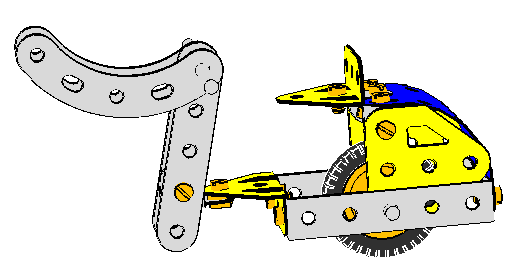
Figure 12. The fork in raised position.
We should now rotate the fork to the correct, downward position. We have several choices: we can rotate each part individually until things line up correctly. Or we can add the wheel, in order to "lock" the fork so that it moves as a unit. Or, we can use a little trick: we insert a dummy Axle Rod through corresponding
holes on either side of the fork. This also “locks” the fork. Then we position the unit in the desired downward position, and can simply remove the Axle Rod afterwards. This method is the easiest to implement.
Rotate the model so that the last holes of the fork arms are aligned and you can see through both. Select an Axle Rod in the Parts Bar (any Rod will do, they are all long enough to go through both holes). Click on the holes and the Rod is added. Now the fork assembly will move as a whole. Double-click one of the arms,
verify that the rotation arrows are displayed around the handle-bar, and drag the green arrow to rotate the fork into the correct position. The correct position is reached when the second hole from the top of each fork's arm coincides with the second hole of the corresponding Strip No. 5. Now we can select the dummy Axle
Rod and delete it.
Moving on, let's do the front wheel. At the end of each fork arm you need to add a Fishplate No. 10, using its elongated hole, and a Washer. See Figure 1 and Figure 9 for details. Once again, we want to line up the Fishplates so that the Rod can be threaded through both.
To mount the wheel, proceed in a similar way as before. Select the Axle Rod part No. 18b in the Parts Bar, then click on the hole of the nearest Fishplate. The Rod is added through both Fishplates. (If you click on the hole of the farthest Fishplate, the Rod is added through the farthest Fishplate only.)
With the Rod still selected, double click on Pulley No. 22. It is added between the Fishplates. (If not, you can correct the Rod and Pulley position using Ctrl+Drag. Any time a Rod or Pulley needs to be moved beyond its natural stop, simply press Ctrl while dragging the red arrow.) Now centre the Axle Rod through the forks,
and centre the wheel on the Axle Rod. Finally, add the Motor Tyre to the Pulley.
The little forks now carry the wheel, but they need to be rotated about their Bolts so that they rake backwards. First of all, unhook ONE of the Bolts. Double-click the OTHER Fishplate (which is still hooked). Select the Bolt around which you want to rotate the little fork. Using Figure 1 for reference, rotate the little
fork assembly (both forks and the wheel). You can also slide it to the extreme end of the elongated holes on the Fishplates, using the big arrows. Once the assembly is in place, remember to rehook the unhooked Bolt.
Examine the “headlights” in Figure 9. These consist of an Angle Bracket No. 12 at each side of the fork. Bolt them on through their elongated hole, inserting a Washer between the Bracket and the Strip. The Washers should give you the correct alignment with the holes of the Plastic Plate that will form the front of the
Scooter. Position the Angle Brackets on the outside of the fork. They may need to be rotated, and you can do this one at a time.
Your model should now resemble the one in Figure 13. You are almost done!
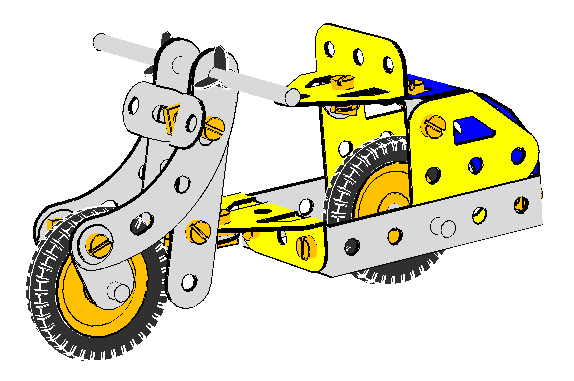
Figure 13. The model is almost complete.
To add the front Plastic Plate, click in the forward hole of one of the Angle Brackets and add a Plastic Plate No. 194 to the new Bolt. Choose the correct hole in the Plate and then orient the Plate correctly. Verify that the hole of the other Angle Bracket almost lines up with the required hole in the Plate (this is
why we added the Washers). You may want to slide the Plate slightly so that the holes line up better.
The Plate needs to be bent to look good. But because you cannot bend something that is attached at several points, you cannot attach the second Bolt yet. You need to bend the Plate before you attach it further. Start as for the rear Plate, and smoothen the bend until you are satisfied.
Sometimes it helps to temporarily hide some parts of the model from view, so you can concentrate on the part you are working with at the moment. In this case, you may want to hide one side of the fork. First select a Perforated Strip No. 5, then, while holding down the Shift key, select the corresponding Curved Strip.
Both the Strips are now selected (red outline). Click the menu Model Hide Selected Parts and they will disappear.
You can now bend the Plate carefully until it follows the curve of the visible fork, and finish by clicking Model Unhide to see the whole model again.
Now, at last, you can add the second Bolt to the Plate with its Nut. Finally add the third Bolt and a Washer to hold the windscreen; the windscreen is a Transparent Plastic Plate No. 193. The model is now complete and should look like the one shown in Figure 1. Remember to Save your work!
Finishing touches.
Let's add some finishing touches. Since you have built a Scooter model, it would be nice if it could steer! VirtualMEC lets you identify a group of parts that can be moved together. These groups are called units and they can perform simple movements, e.g. rotation and/or translation. Let's proceed to define a
Steering Unit.
Select the menu Model Unit. The Unit dialog box appears. Click New Unit, give the Unit a name, for example Steering Assembly, and click OK. With the Unit dialog box still open, identify the part of the model from which the Steering Assembly’s movement originates (the Master part). This part is the Fishplate that is lock-nutted
to the central Trunnion. Select it (if you need to rotate the model to see it better, do so), and, once the Fishplate is selected, click Set as Master.
Now you should identify the part around which the Fishplate will rotate (the Pivot part). This part is the lock-nutted Bolt, so select the Bolt and click Set as Pivot. A set of arrows appears around the pivot. They represent all the available movements for the Unit. To steer a Scooter you need just one movement and you
should disable all the others. Simply click once on each unwanted arrow and it will turn grey, but do not click on the big green arrow, which is the movement we want. If you make a mistake, or if the arrows disappear because you clicked somewhere else, simply re-select the Bolt, click Set as Pivot, and start again.
Finally, you should tell VirtualMEC that the Steering Assembly (the Unit) consists of the Fishplate (the Master part) and all the parts connected to it, but NOT the central Trunnion (the Stop part). When you steer, this Trunnion (and all the parts connected to it) should not move – That’s why it’s called the Stop part.
So, select the Trunnion and click Set as Stop. To verify that everything is correct before leaving the Unit dialog box, click Select Unit. You should see that all the parts forming the Steering Unit are selected (red outline). Now click outside the model and close the Unit dialog box.
Once you have created a Unit, you can recall it at any time to move it. Locate the Current Unit combo box (it should be empty if nothing is selected), and click the pulldown button. You can now select Steering Assembly, or whatever name you just gave the Unit, and a green arrow should appear. Drag the green arrow to
operate the steering. Click outside the model when you are done.
Other features.
VirtualMEC provides another nice feature: the ability to save Viewpoints. Suppose you have rotated the model so that you see the Scooter from the front. You can save this viewpoint and recall it whenever you like. Proceed as follows: rotate the model until you have a nice front view of the Scooter. Click the menu
View Viewpoints, type a name for the view, for example Front, then click Save. Later, when you want to recall that view, simply reopen the Viewpoints dialog and choose the desired view from the list. If you name a viewpoint "Default" (without quotes), the corresponding view will be automatically recalled when
you open a saved model and when you press the keyboard Home button.
Let's briefly explore some other VirtualMEC features.
Click the Semi-real Rendering button or choose Real Rendering from the View menu to switch to more realistic views of your model with lights and shades.
Select Model Part List menu to have a complete List of Parts required to build your model. You can also export the list to a text file.
If you wish to Save an Image, simply click on File Save Image As, and choose one of several common formats (bmp, gif, etc). This is helpful if you want to illustrate building instructions. This feature is available only in the retail version of VirtualMEC.
You can Playback the whole building process of your model from the beginning by choosing View Player. A VCR-style console appears. By operating the console you can review all the building stages of your model one step at a time or continuously in each direction. This feature is available only in the retail version
of VirtualMEC.
You can also Print the model. Select File Print or Print Preview. Printing doesn’t simply transfer what you see on your monitor to paper: it re-renders the image at the resolution of the printer. This can take time but the end result is well worth the wait. This feature is available only in the retail version
of VirtualMEC.
That's all for this Tutorial. You can now start to build your own models. For any issues not covered in this tutorial and for a more detailed discussion of every VirtualMEC feature, please consult the Help on Line.
Have fun with VirtualMEC!